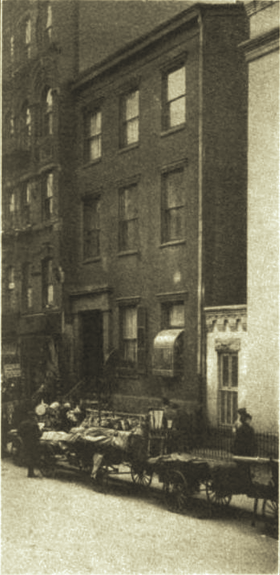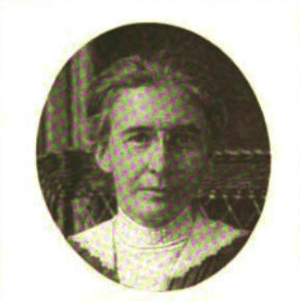Rivington Street Settlement facts for kids

Rivington Street Settlement (1914)
|
|
| Purpose | social reform |
|---|---|
| Headquarters | 95 Rivington Street |
| Location |
|
|
Region served
|
Lower East Side of the Manhattan |
|
Headworker
|
Jean Gurney Fine Spahr |
|
Parent organization
|
College Settlements Association |
The Rivington Street Settlement (also called the New York College Settlement) was a special kind of community center. It was part of the settlement movement, which aimed to help people in poor neighborhoods. This settlement house offered education and social support on the Lower East Side of Manhattan in New York City, New York.
It was supported by the College Settlements Association (CSA). The settlement focused on helping the many immigrant families living in the area. It started at 95 Rivington Street in 1889. Later, it moved to other locations, including a summer home in Mount Ivy, New York. The Rivington Street Settlement was unique because it was started and run mostly by college women. It was like a real-world classroom for studying how people lived and worked in city neighborhoods.
Contents
History of the Rivington Street Settlement
The first Rivington Street Settlement house opened on September 1, 1889. It was founded by the College Settlements Association (CSA). Jean Gurney Fine Spahr was its first leader, called the "head worker."
The main goal was to create a home in a working-class neighborhood. Educated women would live there to connect with local people. This helped everyone learn from each other and benefit mutually. The CSA provided yearly donations and helped raise money to keep the settlement running. Most of the people living in the neighborhood were Jewish immigrants.
In 1891, the building at 95 Rivington Street became available for sale. The Settlement didn't have enough money to buy it. Also, it wasn't officially a company, so it couldn't legally own property. Six friends of the settlement stepped in to help. They loaned the money needed to buy the building.
A group called the Rivington Settlement Company was formed to buy and hold the property. The settlement agreed to pay the loan interest, taxes, and repair costs instead of rent. This arrangement allowed the Rivington Street Settlement to continue its important work. The hope was that over time, the settlement would be able to fully own the building.
What the Settlement Did for the Community
The Rivington Street Settlement was very active in helping its community. It worked to understand and improve life for people in the Lower East Side.
Studying Community Needs
For many years, the settlement studied social issues. They looked closely at the lives and work of women and children. They also did specific local studies. For example, they investigated unemployment in 1894. They collected information for committees studying housing and working conditions. They also studied why people were being evicted from their homes.
Improving the Neighborhood
The settlement worked hard to make the district a better place to live.
Better Housing
In 1894-1895 and again in 1900, the settlement shared its findings with housing committees. From 1899 to 1900, four residents lived in a local apartment building. They reported on their experiences to help improve housing. The settlement also taught people about good hygiene. They encouraged tenants to take responsibility for keeping their homes clean.
Clean Streets and Waste
The settlement constantly worked for better sanitation. In 1894-1895, they helped the street commissioner with a public awareness plan. They also spoke up against unfair treatment of street vendors.
More Play Spaces
The settlement supported efforts to create more parks and playgrounds. In 1897-1898, it became the main office for the East Side Recreation Society. They encouraged the school board to open playgrounds during school breaks. They even had an official school visitor living at the settlement.
Supporting Public Schools
The settlement had strong ties with local schools. Since 1889, they worked to get better facilities for children. They put small libraries in schools and helped teachers with individual students. They also offered informal school visits and a night school after public schools closed. They ran kindergartens and special classes for children who needed extra help. The head worker of the settlement was on the local school board for eight years.
Helping Workers
In 1894, the settlement supported garment workers. They continued to help labor unions they could reach. They spoke to government committees about improving working conditions for women and children. Their studies helped raise public awareness about these issues. They also worked with other groups to make sure labor laws were followed in local stores and factories.
Economic Support
The settlement helped with a co-op project in 1893. It became a center for relief efforts during economic hard times. This included the depressions of 1893-1894, 1900, and 1907-1908. They made sure the public knew about the neighborhood's needs. They also provided direct help to the people they served.
Local Services and Programs
The Rivington Street Settlement offered many direct services. They provided public baths for women. They also had a private playground in their yard. The settlement offered library services, including a visiting library service. They even started a music school. This music school later grew into the famous Third Street Music School Settlement.
How the Settlement Operated
In 1911, twelve women and two men lived at the Rivington Street Settlement. They were called "residents."
A key role of the settlement was to keep the city aware of the neighborhood's needs. They helped wealthy people understand the lives of those on the East Side. They also taught college women about modern city conditions.
The Rivington Street Settlement offered many programs:
- A kindergarten (though nursing services stopped).
- School visiting programs.
- A gymnasium and a clubhouse for boys.
- An athletic association.
- A cooking school.
- Classes for gymnastics, singing, and dancing.
- Clubs for married women, men, young people, and children.
- Entertainments, concerts, and lectures.
During the summer, they had special activities:
- The house was open for dances and games.
- The gymnasium became a playground.
- They had a playground in the backyard.
- An ice-water fountain was available.
- They gave out flowers.
- They organized picnics and excursions.
- Their summer home in Mount Ivy, New York, offered vacation time. This was one of the best summer vacation programs of its kind.
Notable People at the Settlement
Many important people were involved with the Rivington Street Settlement:
- Fannie W. McLean, a resident from July 1892 to July 1893.
- Dr. Jane Elizabeth Robbins, a resident from 1893 to January 1898.
- Eleanor Roosevelt, who taught exercise and dancing classes.
- Mary Kingsbury Simkhovitch, a resident from January 1898 to November 1898.
- Jean Gurney Fine Spahr, a resident and the first head worker from October 1889 to July 1892.
- Elizabeth Sprague Williams, a resident starting November 1898.
- Helen Rand Thayer, one of the co-founders.


